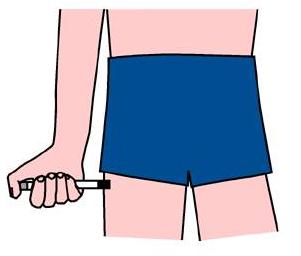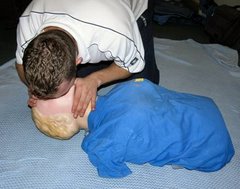Severe Allergic Reactions (Anaphylaxis)
Anaphylaxis is a severe allergic reaction with symptoms that develop within minutes of being triggered. It causes swelling of the airways resulting in impaired breathing, collapse and is potentially fatal. A casualty experiencing anaphylaxis needs urgent medical attention immediately - don't delay calling an ambulance.
Quite often the casualty knows that they suffer from anaphylaxis and they make adjustments to their life to avoid the triggering factor. Those with severe allergies also carry medication as a precaution. Some of the more common triggers include peanuts, fish, rubber, dust and insect stings. Be aware that a person can suddenly develop a severe reaction to a product they have had trouble-free exposure to in the past.
Recognition:
Quite often the casualty knows that they suffer from anaphylaxis and they make adjustments to their life to avoid the triggering factor. Those with severe allergies also carry medication as a precaution. Some of the more common triggers include peanuts, fish, rubber, dust and insect stings. Be aware that a person can suddenly develop a severe reaction to a product they have had trouble-free exposure to in the past.
Recognition:
- Impaired breathing.
- Wheezing and gasping for air.
- Signs of shock.
- Widespread blotchiness of the skin.
- Swelling of the lips, tongue and throat.
- Puffiness of the eyes.
- Anxiety.
Treatment:
- Call for an ambulance immediately.
- Check the casualty for medication and medi-lert bracelet.
- Help the casualty to administer their medication. Sufferers of severe allergies usually carry epinephrine (adrenaline) in an auto injector commonly known as an EpiPen (the brand name of the product).
- Simply remove the auto-injector from its tube.
- Remove the protective cap and strike the needle (narrow) end into the casualty's upper thigh at a right angle to the skin.
- Hold the injector on the thigh for 10 seconds before removing and massaging the injection area for 10 seconds.
- BE CAREFUL with the used needle and dispose of it safely by sealing it back in the EpiPen tube.
- If the casualty is conscious sit them in the position that makes breathing easiest.
- If the casualty becomes unconscious place them in the recovery position.
- Carefully monitor the casualty's airway and breathing.
- Be prepared to give CPR if the casualty stops breathing.
ANAPHYLAXIS NEEDS URGENT MEDICAL ATTENTION - SUMMON HELP IMMEDIATELY.



